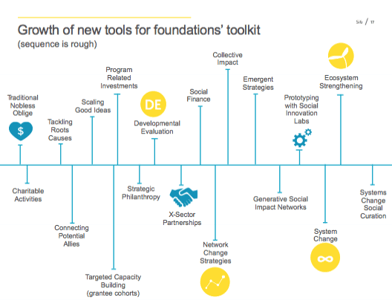Last November, J.W. McConnell Family Foundation President and CEO, Stephen Huddart, gave a talk at MaRS Discovery District that sketched out the emerging path being trail blazed by contemporary foundations. It is a path that is as significant for how it is being created emergently and collaboratively as it is for its destination system changes generating positive social and environmental outcomes.

Foundations are embracing a growing toolkit for social change that is more multifaceted than ever. As the toolkit expands and shifts in response to an intensifying appreciation for the complex and systemic nature of social and ecological problems, foundations like McConnell are seeking insights about their role as a vital part of what Rideau Foundation’s Managing Director, Vinod Rajasekaran, calls "Canada’s R+D engine" for the country’s future wellbeing and sustainability.
At the same time, however, these empowering new tools i.e. Collective Impact, social innovation, social labs, impact investing, cocreation, coproduction, developmental evaluation etc. throw up new challenges for foundations. They are rooted in a seismic shift towards working in more collaborative ways with partners, grantees and unusual suspects like governments and corporations. Such a shift requires foundations to also change their mindset: they are not just the funder/enabler, but also the active partner and cocreator of new collaborative partnerships among societal actors. These new collaborations make it possible to generate new value benefiting community.
Foundations as Partners versus Foundations as Protagonists
These shifts are moving foundations and community organizations along the working together continuum towards trust and integrated partnership.
"This is really a corrective to some of the pathologies of traditional philanthropy. Most philanthropy is driven by the very personal ideas and needs of the donors, whereas Collective Impact has the potential to create more communitybased solutions and approaches."
~ Tim Brodhead, quoted by Larry Gemmel, "Letter from the guest editor," The Philanthropist 26.1 (2014). 310.
As Tim Brodhead noted, these new models of working together such as collective impact serve as an opportunity to move beyond traditional philanthropy’s power paradigm, as foundations think and act past simply leveraging the hard power of resources towards cultivating soft power through collaboration, empowering partners and enabling the agency of a generative network of others to bring about system change.
McConnell, Tamarack and the Caledon Institute’s partnership on Vibrant CommunitiesCities Reducing Poverty exemplifies the opportunity of this shift. It is based on growing social change through a generative and collaborative network. The growing network creatively unleashes more diverse methodologies for achieving change and clarifies the agenda for approaching system change.
The critical skill fueling the recoding of relationships between foundations and grantees towards partnership is empathy. As foundations embrace uncertainty, emergence and empathy empowered by the growing toolkit for evaluating, supporting and participating in collaborative initiatives they become more prepared to nourish the conditions for systems change.




